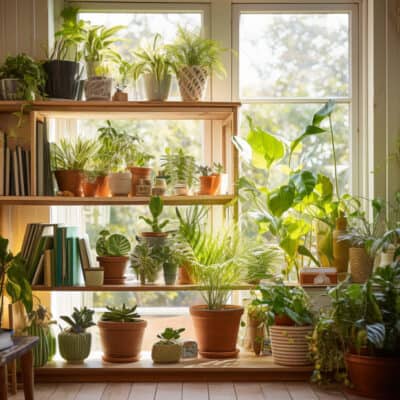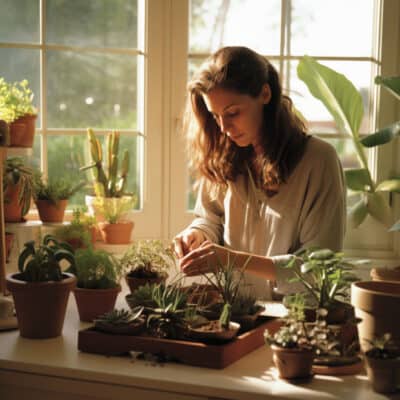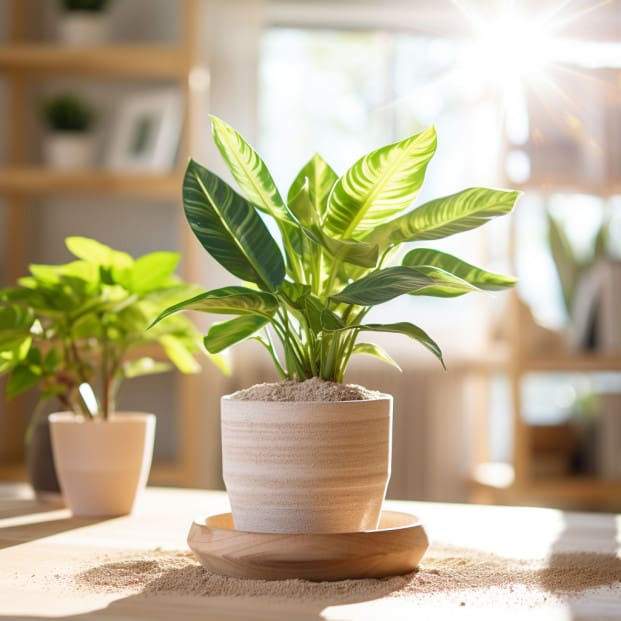Diatomaceous earth can keep indoor plants healthy and vibrant.
It works wonders for draining excess soil moisture and improving roots.
You may have heard that DE absorbs moisture, but what you place absorb moisture, but what you may not know is how well it fights pests like bugs and larvae.
DE is actually tiny fossilized algae shells that are sharp like tiny shards of glass to soft-bodied insects.
The microscopic pores and sharp edges cut their exoskeletons.
This natural remedy leaves plants shining rather than using harsh chemicals.
Children will love growing up around green, thriving plants instead of toxic sprays.
Whether you need healthy plants or pest control, diatomaceous earth should be your new secret weapon.
When used correctly, it provides both without risks to humans.
Keep reading to discover how to properly apply it for best results while protecting your family.
KEY TAKEAWAY
Diatomaceous earth for indoor plants, what to know?
Diatomaceous earth is a natural and effective solution for controlling pests in indoor plants.
Sprinkle a thin layer on the soil’s surface to create a barrier that deters insects while being safe for your plants.
Unveiling the Magic: What is Diatomaceous Earth?
Diatomaceous earth is a chalky-like powder made from tiny fossilized water plants called diatoms.
Long ago, diatoms lived in ponds and oceans then settled on ocean floors after they passed away.
Over many years as they piled up, the thick layers were compressed into a rock-like material known as diatomaceous earth.
Today, diatomaceous earth is mined from the earth and processed.
This magical dust has benefits for indoor plants and the indoor garden.
Guardians of Greenery: Using Diatomaceous Food Grade Earth for Pest Control

Fungus gnats and spider mites can be common plant pests. (1)
Fungus gnats lay eggs in potting soil near the top soil layer.
When the eggs hatch, the baby fungus gnats feed on fungi in the soil.
Spider mites suck the juice from plant leaves which can cause stippling on leaves.
Food grade diatomaceous earth is an organic and natural way to manage these pests without harming beneficial insects.
When applied to soil, the sharp edges of diatomaceous earth particles cut the waxy coating on the tiny pests’ exoskeletons, causing them to dehydrate and die.
To apply diatomaceous earth to houseplants, first water the plant thoroughly so the top inch of soil is moist.
This will help the powder adhere better to the soil.
Generously sprinkle food grade diatomaceous earth on the top of the potting soil and lightly mix into the top half inch.
The powder needs to stay dry to work so avoid overwatering after applying.
Reapply every 4-6 weeks or after watering to catch newly hatched pests.
You can also mix a teaspoon of diatomaceous earth into the potting soil when repotting indoor plants.
The powder will then be in place to protect newly planted roots and stem bases from soil pests like fungus gnats.
Be sure to only use food grade diatomaceous earth meant for indoor and outdoor use near plants.
Diatomaceous earth is generally safe for use on and near houseplants but a dust mask is recommended when applying the powder to prevent inhalation.
Neem oil is another organic treatment option but can harm beneficial insects when misused.
Instead of harsh chemicals that pollute the home and environment, try diatomaceous earth first for a natural solution to pest problems in the indoor garden.
The magic of this ancient mineral works quietly to defend potted plants.
Beneath the Surface: Diatomaceous Earth in Soil Mixes
Diatomaceous earth (2) powder can be mixed into potting soils for houseplants.
The powder works as a water retaining agent in soilless mixes and adds beneficial minerals to regular potting soils.
When applying diatomaceous earth to the soil, it forms a layer beneath the surface that can protect roots and stem bases from houseplant pests.
Fungus gnats are especially drawn to lay eggs at the top of the soil.
Mixing diatomaceous earth into the whole soil profile makes it harder for eggs and insect larvae to avoid contact with the sharp fossilized remains.
For outdoor plants, incorporating it in soil also helps control pests like cutworms and flea beetles without using harsh pesticides.
Diatomaceous Earth 101: Safety for Humans & Pets

Diatomaceous earth comes from the fossilized remains of tiny diatoms, an organic sedimentary rock.
While effective against house plant pests and insects, concerns about safety for children and pets are understandable.
When applying the powder, take safety precautions like wearing a dust mask and gloves and keeping pets away from treated areas until the powder dries.
Properly used, diatomaceous earth is safe for humans however it is not advised to directly sprinkle the powder where people and animals may inhale it.
With responsible use and basic care, diatomaceous earth is a non-toxic tool to naturally rid of fungus gnats without risk to family health.
Always follow package directions and use only foods grade varieties approved for organic use.
Beyond Bugs: Diatomaceous Earth’s Additional Uses
Diatomaceous earth has little known uses other than defending against garden pests.
First, it can be mixed with water in a spray bottle to quickly dust house plants, potted and hanging plants, and foliage.
The natural powdery substance coats all surfaces to cut fungus gnat larvae and mites.
Next, diatomaceous earth sprinkled on indoor and outdoor top posts and window sills creates an abrasive barrier bed bugs and ants cannot cross.
Lastly, using a powder on top potting mix kills fungus gnats without repotting plants or disturbing roots.
Its sharp fragments puncture fungus gnat bodies from all sides.
Optimizing Growth: How Much Diatomaceous Earth to Use in Soil?
Like most things, using the right amount of diatomaceous earth direct in soil is important.
Too much can clump soil and too little will not protect efficiently.
Most house plant soil recipes call for about 1 tablespoon of sedimentary rock powder per gallon of potting mix.
Another option is sprinkling a thin layer on top soil then gently mixing just the top inch.
Remember this white powder comes from tiny lifeforms and rock unlike chemicals.
Too much will not harm plants but may not help.
As an insecticidal soap replacement, try 1⁄2 tablespoon diatomaceous earth per gallon initially and assess results before applying the diatomaceous earth directly to potted soils long-term.
Start low and go slower with this magical mineral.
Dust to Thrive: Diatomaceous Earth’s Impact on Indoor Plant Health

Diatomaceous earth does more than fight houseplant pests – its magic also boosts the whole plant health.
When sprinkled as a thin layer on soil, the tiny particles settle into fine pores and crevices, acting like additional root hairs to absorb water and nutrients.
This improves hydration and uptake of minerals at the base of the plant.
Also, diatomaceous earth absorbs excess moisture that can lead to root rot.
Its porous structure aerates soil for optimal growing conditions.
Best of all, organic methods like using diatomaceous earth strengthen overall plant hardiness and resistance compared to harsh chemicals.
In Harmony with Nature: Balancing Act of Diatomaceous Earth
While a helpful tool, diatomaceous earth is still a non-selective pest killer affecting beneficial insects‘ life cycle.
Used alone or excessively, it can disrupt the natural harmony in the indoor ecosystem and soil web of life.
A balanced approach is key – wear gloves when handling and dust targeted areas sparingly as needed with a salt shaker bottle.
Pairing diatomaceous earth treatments with other techniques like sticky traps allows good bugs to also eat adult fungus gnats.
Always thoroughly rinse hands and change clothes before contact with people after use.
Keep reading for more tips on preserving balance while enjoying this natural defense for diatomaceous earth on your houseplants.
Used judiciously as one piece of a wildlife-friendly program, it is an effective companion to any plant care routine.
Conclusion
In summary, diatomaceous earth is a handy tool for indoor plant care that does more than fight pests.
When applied judiciously to soil or plants, its tiny particles improve hydration, uptake of nutrients and prevent root rot.
Additionally, it supports the health of whole plants by strengthening them from the base up.
However, in any indoor ecosystem, balance is key.
Diatomaceous earth does harm beneficial insects if overused.
The most effective approach combines it with other organic methods like sticky traps.
This protects good bugs and allows their role in the natural harmony while providing defense from common houseplant predators.
With care and moderation, diatomaceous earth enhances both the beauty and longevity of any home’s indoor greenery for years to come.
Frequently Asked Questions
How can I use diatomaceous earth on house plants?
Diatomaceous earth can be safely applied to house plant leaves and stems.
Dust or lightly spray the powder onto all surfaces of the plant using a salt shaker or spray bottle.
Be sure to cover the tops and undersides of leaves.
Reapply every 2-4 weeks.
Can I add diatomaceous earth to plant leaves?
Yes, diatomaceous earth is commonly used on plant foliage to control pests like aphids and spider mites.
Apply a thin, even coating to all leaf surfaces.
Reapply after rain or weekly for prevention.
Take care not to inhale the powder and wear a dust mask.
What is the best way to apply diatomaceous earth indoors?
For indoor use, the safest methods are sprinkling the powder on top of potting soil or mixing a small amount into the top layer of soil when repotting.
You can also apply it with a salt shaker or spray bottle, but precautions like gloves and a dust mask are recommended to avoid inhaling the powder.
How do I add diatomaceous earth to potting soil?
When mixing diatomaceous earth into potting soil, start with 1 tablespoon per gallon and mix thoroughly.
For individual pots, work 1/2 tsp into the top 1-2 inches of soil.
Reapply every 2-4 months and after watering to protect new plant growth.
Rotate applications with other organic pest controls.
Will using diatomaceous earth on houseplants hurt them?
When used as directed, diatomaceous earth is generally harmless to plants.
Concentrations over 5% by volume could potentially dry out sensitive foliage.
It’s best to do a small test application first and rinse off any visible dust from leaves if you notice browning.
Most houseplants tolerate low, monthly applications.
Can diatomaceous earth kill houseplants?
No, properly applied food-grade diatomaceous earth will not directly kill houseplants.
As a dessicant, very high concentrations could theoretically dry out plants over time by disrupting their waxy coatings.
But used as directed in soil or at 1-2 tsp/gallon respectively, it will not damage plants intended for indoor use.
How do I mix diatomaceous earth with potting soil?
To incorporate diatomaceous earth into potting soil, start by mixing 1-2 tbsp per gallon of dry soil.
For individual pots, work 1/2-1 tsp into the top 1-2 inches where pests reside.
Use a spoon or your hands to work the powder thoroughly throughout the soil surface.
Reapply every 2-3 months as a preventative measure.
Rotate with other organic solutions.
Will mixing diatomaceous earth with potting soil hurt plants?
When mixed at recommended rates, diatomaceous earth is generally safe for potted plants.
Too much powder could potentially dry out the soil over time, so start with 1-2 tbsp per gallon of potting mix.
Monitor soil moisture and supplement with water as needed if using DE regularly in potting soil.
Most houseplants tolerate low levels well as part of an integrated pest management plan.
References
- https://primexgardencenter.com/identify-and-get-rid-of-houseplant-pests/#:~:text=Unlike%20fungus%20gnats%2C%20which%20are,this%20is%20called%20leaf%20stippling.
- http://npic.orst.edu/factsheets/degen.html
Related Articles
- https://allthingsgardener.com/how-to-get-rid-of-bugs-from-houseplants/
- https://allthingsgardener.com/diatomaceous-earth-to-kill-aphids/
- https://allthingsgardener.com/slow-growing-indoor-plants/


